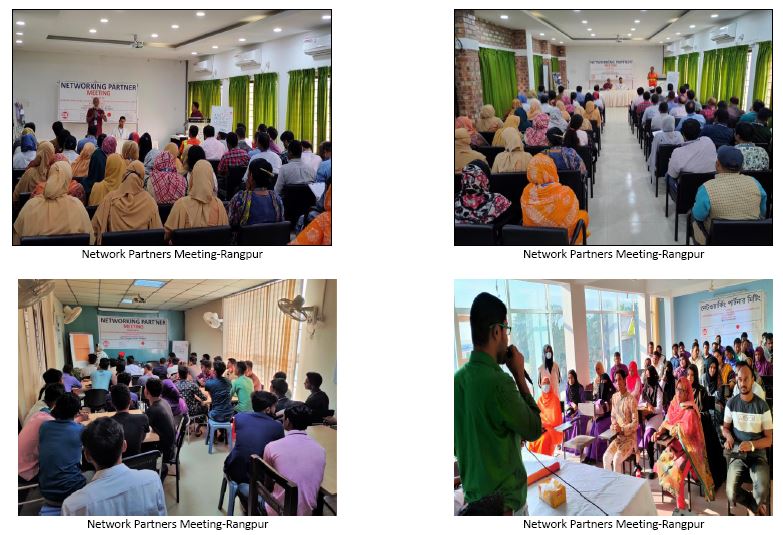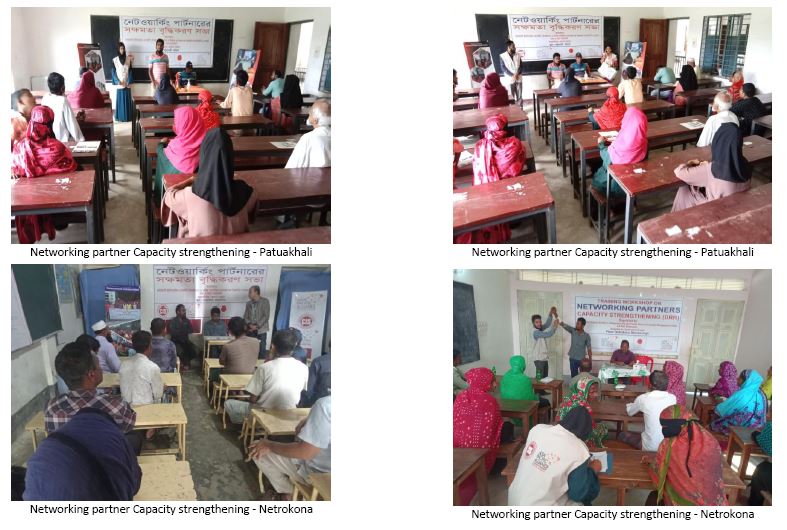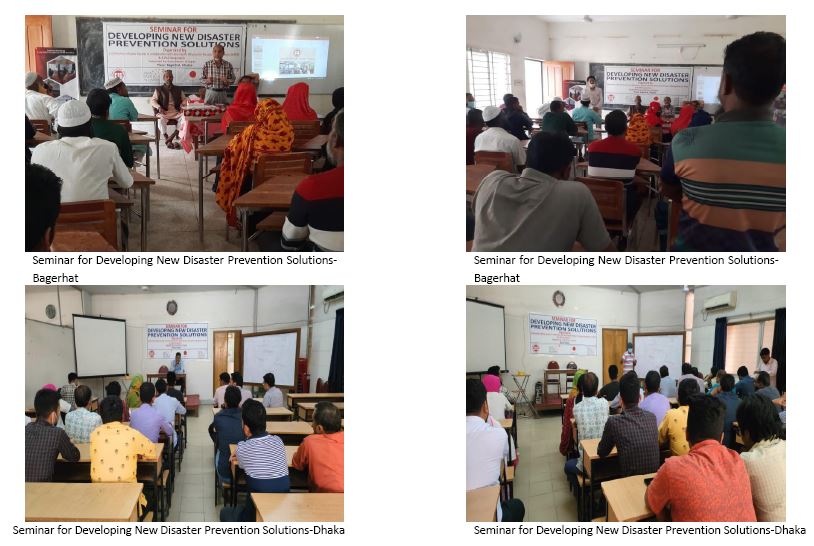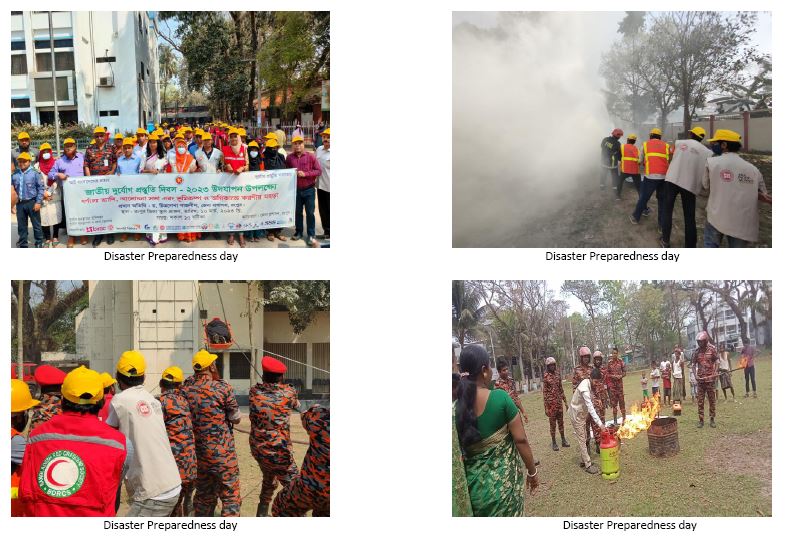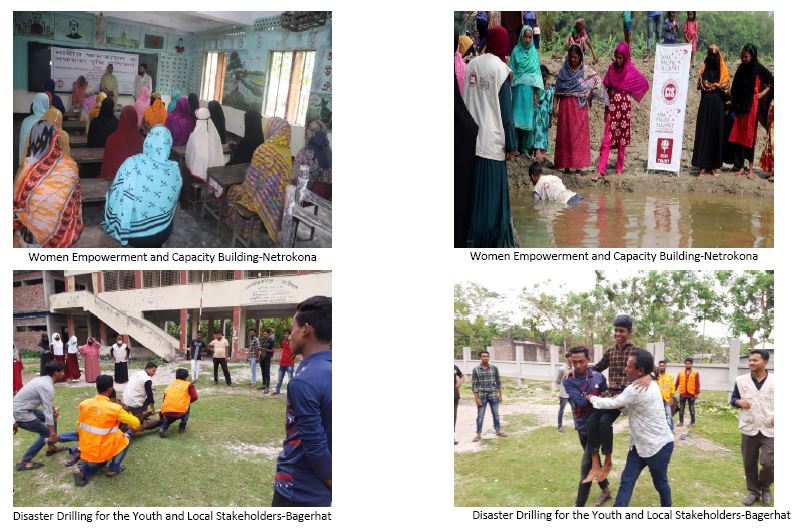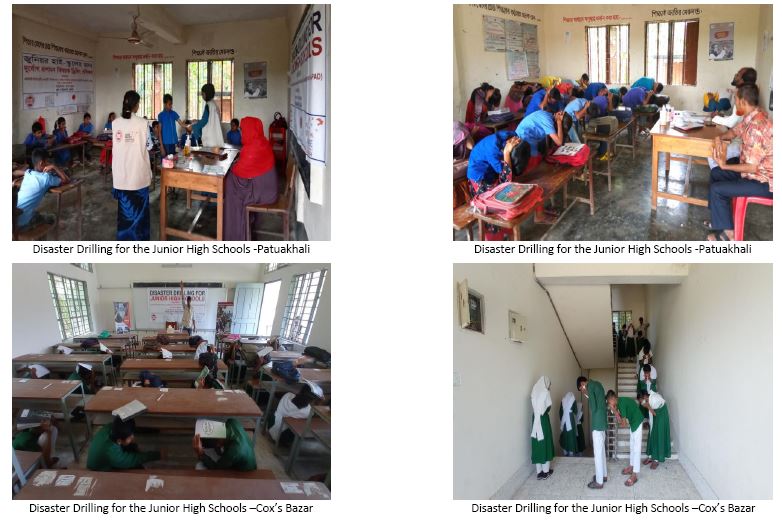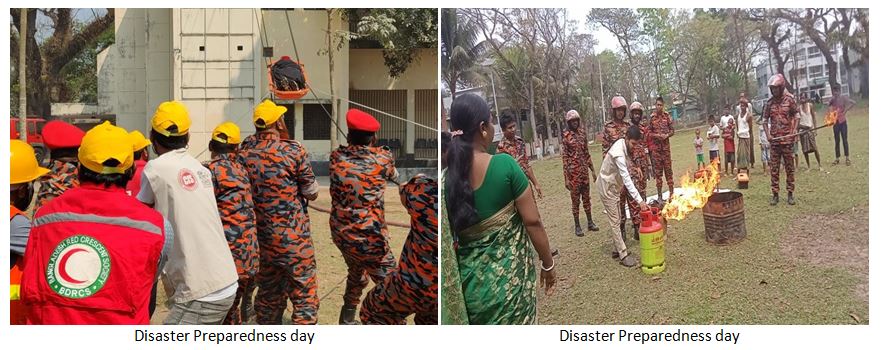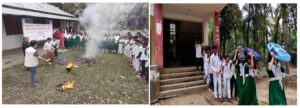Project Title: Strengthening Capacity for Sustainable Disaster Management Network by involving multi-sectoral platform Project Period: 17 January, 2023 – 16 January, 2024 (12 month)
- Project Activities and Accomplishments
Bangladesh is one of the most vulnerable countries to natural disasters and, due to climate change; we are facing natural disasters almost every year. Combined with the country’s geographical location, topography, and dense population, disaster events often result in high loss of life and economic loss, though Bangladesh has been successfully reducing the loss of human lives over the years. The frequency and intensity of natural disasters have been increased in recent years due t o climate change. The climatic events have serious consequences on broad agricultural sectors, food security, water, health and sanitation and leave serious impacts on life and livelihood of the communities. But so far we have limited disaster risk related data to understand the depth of household and population characteristics and loss sustained by the community at the household levels.
A-PAD Bangladesh started project from January 2023 and presently continue it 17 January 2023 to build up capacity on disaster management. It communicates with the different sectors like local community, community leaders, stakeholders, GOVT. officials continuing training on disaster management. To hold training program A-PAD Bangladesh staff organized small community meeting to sharing ideas on disaster and introduced them about A-PAD Bangladesh activity. A-PAD Bangladesh working 8 divisional areas.
There are 1 health workers in each divisions whose are doing home visit and aware the local community about basic disaster awareness. The health workers gave basic ideas about disaster management. A-PAD Bangladesh working at the rural areas. If there would be any directions or announcement from GOVT. or any disaster related news has been published the health workers delivered the message to the local community. Total 5,481 persons were benefited from A-PAD Bangladesh on March 2023.
A-PAD Bangladesh attended coordination meeting at the 8 divisions in Office of Deputy Commissioner. At that meeting different NGOs had joined and explained their activities. Besides this what will be the next activities of the GOVT. and NGOs were discussed at that meeting.
1. To manage the emergency disaster management coordination centers in disaster-prone areas (Outcome 1) The disaster management coordination center in disaster vulnerable areas established in this project (3 year project) functions as a disaster response base in each region, and contributes for preventing the spread of health damage to local residents and community-led disaster risk reduction measures. | ||
Activities | Outcome Indicators to Measure Results: | Project Status: Achievements vs Outcome: If the activity is behind the schedule, please write the reason. |
1-1 Operation of Emergency Disaster Management Coordination Centers Beneficiaries: 10 people x 25 days x 8 divisions x 12 months = 24,000 people 50 people x 8 campaign x 12 months = 4,800 people | 【Indicators of Outcome】 1-1: The disaster response management centers in 8 places (Dhaka, Chattagram, Rajshahi, Khulna, Barisal, Sylhet, Rangpur and Mymensingh division) will be utilized and the necessary equipment for emergency health care will be prepared. We will establish a new emergency disaster management coordination center in Mymensingh division. The center will function as a resource center for sharing information on disasters and will be used as a venue for strategic planning meetings, training and workshops. The staff members including doctors and nurses visit the villages and carry out awareness activities related to emergency health measures, public health and disaster prevention for local residents, and ensure that each local resident takes appropriate preventive measures. | Total 2,800 people visited to the Disaster Management Coordination Center to discuss about disaster preparedness and health related issues. Dhaka: 330 Persons Cox’s Bazar: 400 Persons Pabna: 375 Persons Bagerhat: 410 Persons Patuakhali: 365 Persons Habiganj: 370 Persons Rangpur: 320 Persons Netrokona: 230 Persons Total = 2,800 Persons |
1-2 Disaster Management Awareness program Beneficiaries:15 participants x 3 sessions x 8 divisions x 12 months = 4,320 people | A-PAD Bangladesh conducted Disaster Management Awareness programs at the 8 divisional areas where 390 persons have participated. Total 3 times training organized at each divisional areas. Dhaka:15 Participantsx 3 Sessons= 45+3=48 Participants | |
| (Indicator: number of visitors, record of services provided)
1-2: The PCR test lab installed in the previous project will continue to operate. In the first year of the project, testing will be conducted only for COVID-19. From the second year onwards, it will be expanded to other infectious diseases (tuberculosis, measles, hepatitis) according to the needs of local residents. (Indicator: number of tests, report of test results) | Cox’s Bazar: 15 Participantsx 3 Sessons= 45+3=48 Participants Pabna: 15 Participantsx 3 Sessons= 45+6=50 Participants Bagerhat: 15 Participantsx 3 Sessons= 45+2=47 Participants Patuakhali: 15 Participantsx 3 Sessons= 45+6=51 Participants Habiganj: 15 Participantsx 3 Sessons= 45+4= 49 Participants Rangpur: 15 Participantsx 3 Sessons= 45+5=50 Participants Netrokona: 15 Participantsx 3 Sessons= 45+2=47 Participants |
1-3 Operation of PCR lab Beneficiaries: 15 people x 25 days x 12 months = 4500 people(Monthly Goal: 15 persons x 25 days = 375 persons) |
A-PAD Bangladesh established PCR Lab for COVID-19 test. In Bangladesh number of COVID-19 patients has average in number. In February 2023 total 450 COVID-19 test has been done | |
2 Strengthening the disaster response platform network (Outcome 2) A-PAD BGD, NPF for disaster reduction and disaster response through collaboration between multi-sectors, will be established and expanded, and the disaster prevention and disaster capacity of its member organizations will be strengthened. | ||
2-1 Network partner meeting Participants : 100 people x 5 villages x 8 divisions = 4000 | 【Indicators of Outcome】 2-1 Strategies, mechanism and action plan meeting among networking partners and local communities | A-PAD Bangladesh conducted Networking Partner meeting at Rangpur total 518 participants joined the network partner meeting. 19 March 2023- Taluk Dhomodashpur, Total participants |
people | will be held to support the building of disaster cooperation framework.
2-2 For the aim of awareness and increase the knowledge on disaster preparedness and management among the local community, we will organize different rally and meeting on the disaster preparedness and SDGs related national/international days like 05 November World Tsunami Awareness Day, 13 October Disaster Risk Reduction Day, 22 April Earth Day and 16 December Victory Day (National).
2-3 For the aim of strengthening of partner organizations, disaster risk reduction (DRR) training will be held. The training contents includes community-based disaster risk management, planning DRR strategies, and risk analysis that effectively identifies hazards, capacities and vulnerabilities. (Indicator: Partner organizations)
2-4 In this seminar, participants from various fields will be invited to exchange opinions and discuss ways to discover innovations related to DRR proposed by community residents and local companies and realize ideas and inventions. | 100+ 4 participants 20 March 2023- Dorshona, Total participants 100+ 2 participants 21 March 2023- Arshatpur, Total participants 100+ 5 participants 22 March 2023- Jummapara, Total participants 100+ 3 participants 23 March 2023- East Khaleya, Total participants 100+ 4 participants On The 1 st day the topic was an earthquake. To protect life and property from earthquake disasters, it is imperative to take the following necessary steps to deal with possible earthquakes. 1. Increase public awareness 2. Earthquake preparedness 3. Post-earthquake rescue, relief and reconstruction programs etc. 1. Many people died by falling under the buildings in the earthquake. Increasing public awareness is essential in preparing for potential earthquakes and mitigating the damage. Informing the public about what to do in an earthquake such as: what to do before, during and after an earthquake. Apart from that, what is an earthquake, why it happens and its effects. To make aware of the terrible conditions that can arise if houses are not constructed as planned or if the required building codes |
| (Indicator: To create innovative solutions, we aim to create a successful model for disaster response by combining technology and knowledge that transcends fields and innovating)
2-5 The international symposium will be held in Dhaka to widely share the cooperation between multi-actors at the central and regional levels in Bangladesh and the progress of the emergency health response system among participants who are involved in disaster response from inside and outside Bangladesh. International experts will be dispatched from A-PAD member countries to introduce advanced cases of NPF in each country. (Indicator: The international symposium will be held for a total of three days, one day for field trips (field visits), one day for pre-meetings, and one day for international symposiums.) | are not followed. Below is a discussion of what to do before, after and during an earthquake. All public and private organizations must be prepared in advance for earthquakes. That is why it is important to take proper steps for all the organizations including necessary training to properly concentrate in the post- earthquake period. Overall earthquake preparedness in the current framework is very poor development of pre- preparedness is necessary. 1) To provide an idea about the damage and loss of human life due to flood to the people living in the area. 2) Bringing together youths to elders to hold courtyard meetings to raise awareness about flood prevention. 3) To train the youth of low-lying areas on flood control. 4) Advising people in low-lying areas to build their dwellings before the monsoon season. 5) Provide sufficient bleaching powder to disinfect the habitations of the people of the area after the flood water has gone out and tell the correct rules for its use. 6) In addition to the awareness of the local people to make the city areas flood-free, it is more important to monitor the city corporation to keep the drain lines clean and to keep the used garbage plastic in designated places. |
2-2 Disaster Preparedness Campaigns | A-PAD Bangladesh joined Disaster preparedness day 2023 and participated at the 8 divisional areas. 10 March 2023, Dhaka, Total Participants 100 |
Participants:100 people x 2 times x 8 divisions = 1,600 people |
| 10 March 2023, Cox’s Bazar, Total Participants 100 10 March 2023, Pabna, Total Participants 100 10 March 2023, Bagerhat, Total Participants 100 10 March 2023, Patuakhali, Total Participants 100 10 March 2023, Habiganj, Total Participants 100 10 March 2023, Rangpur, Total Participants 100 10 March 2023, netrokona, Total Participants 100 |
2.3 Network Partners Capacity Strengthening (DRR) Participants:30 people x 2 org x 8 divisions x 2 times =960 people | A-PAD Bangladesh conducted 2 days training program Netrokona and Patuakhali where total 120 participants has joined the training programs. 19-20 March 2023, Netrokona, Total Participants 60 15-16 March 2023, Patuakhali, Total Participants 60 Netrakona is a district located in the Magra River and North East Region in the division of Mymensingh in Bangladesh. It is one of the oldest towns and municipalities in the country. Netrakona municipality was established in 1984. The town covers an area of 183 km² with a population of 22,29,464 according to the 2011 census. Barhatta is situated on the bank of the Ramnabad in Netrakona District. Barhatta Upazila has many rivers and canals. More or less almost every district of this country is affected by the disasters. Among these 64 districts, Netrakona district is the more disaster-prone area.CIS organized a training workshop on network Partner’s Capacity Strengthening DRR in Netrokona. Network Partners Capacity Strengthening (DRR) |
|
| Workshops are rooted in the need to strengthen the capacity of organizations to effectively respond to disasters and reduce the risk of their impacts. Disaster Risk Reduction (DRR) refers to the systematic approach of reducing the impact of disasters on communities, through an understanding of the risks and vulnerabilities and implementing measures to mitigate those risks. The ultimate goal of the Network Partners Capacity Strengthening (DRR) Workshop is to improve the capacity of organizations to respond to disasters and reduce the risk of their impacts, by providing training, support, and opportunities for collaboration and exchange. Patuakhali district is one of the disaster-prone areas in Bangladesh.CIS organized a two days training program on Networking Partners’ Capacity Strengthening (DRR).In this training program, (Cyclone Preparedness Program- CPP) and podokkhep joined. The geographic location of Bangladesh at the confluence of the three mighty river systems of the world renders her one of the most vulnerable places to natural disasters. Huge loss of life and property takes place during disasters due to a lack of organization, coordination and effective communications in disaster response. Cyclones are one of the most destructive natural hazards that pose a serious threat to society, particularly to those in the coastal regions. In this Training Program, there was a discussion on specific |
|
| cyclone disasters and there was also a workshop on what |
to do and what not to do during Cyclone Disaster. | ||
2-4 Seminar for Developing | A-PAD Bangladesh conducted Seminar at the 4 divisional | |
New Disaster Prevention | areas. Netrokona, Habiganj, Dhaka and Bagerhat 4 places | |
Solutions Participants:40persons | seminar organized where 180 participants joined. 12-13 March 2023, Habiganj, Total participants 40+ 4 | |
x 8 divisions x 2times | participants | |
=640 participants | 18-19 March 2023, Dhaka, Total participants 40+ 5 | |
| participants | |
| 19-20 March 2023, Bagerhat, Total participants 40+ 6 | |
| participants | |
| 27-28 March 2023, Netrokona, Total participants 40+ 5 | |
| participants | |
| Developing New Disaster Prevention Solutions Seminar | |
| aims to bring together experts, practitioners, and | |
| policymakers from different sectors to share their | |
| knowledge, experiences, and innovative solutions for | |
| disaster prevention and management. CIS conducted a2 | |
| Days Seminar in Habiganj on Developing New Disaster | |
| Prevention Solutions. The main objective of the Seminar | |
| for Developing New Disaster Prevention Solutions is to | |
| promote knowledge exchange and collaboration among | |
| experts, practitioners, and policymakers in the field of | |
| disaster prevention and management. The seminar | |
| provides a platform to explore the latest research findings |
|
| and best practices in disaster prevention, risk reduction, and response, and to identify new opportunities for collaboration and innovation. The seminar can cover a wide range of topics, including natural disasters such as earthquakes, tsunamis, hurricanes, and floods, as well as technological and man-made disasters such as industrial accidents, cyber-attacks, and pandemics. Participants in the seminar can include disaster management agencies, non-governmental organizations, academics, engineers, architects, urban planners, and other professionals involved in disaster prevention and management. Disasters have massive human and economic costs. They may cause many deaths, severe injuries, and food shortages. Most incidents of severe injuries and deaths occur during the time of impact, whereas disease outbreaks and food shortages often arise much later, depending on the nature and duration of the disaster. Anticipating the potential consequences of disasters can help determine the actions that need to be started before the disaster strikes to minimize its effects. CIS conducted a Seminar in Dhaka for 2 days on Developing New Disaster Prevention Solutions. In this seminar, they discussed The Role of NGOs in Disaster Prevention Solutions in Bangladesh. Non-governmental organizations (NGOs) play a crucial role in disaster prevention solutions in Bangladesh. Here are some of the key roles of NGOs in this |
|
| context: 1. Community awareness and education: NGOs can play a vital role in raising awareness and educating communities about disaster preparedness and prevention. They can organize training programs, workshops, and awareness-raising campaigns to inform communities about the risks of disasters and how to prepare for them. 2. Emergency response: NGOs can provide immediate assistance to communities affected by disasters Bagerhat district is one of the disaster-prone areas in Bangladesh. Community Initiative Society (CIS) organized a Seminar for 2 days on Developing New Disaster Prevention Solutions in Bagerhat. Disasters and emergencies are fundamental reflections of normal life. They are consequences of the way society structures itself, economically and socially; the way societies and states interact; and the way that relationships between the decision-makers are sustained. The disaster emanates from the fact that certain communities or groups are forced to settle in areas susceptible to the impact of a raging river or a volcanic eruption. The magnitude of each disaster, be it in terms of deaths, property damage or costs for a given developing country increases with the increment of marginalization of the population. As the population increases, the best land in both rural and urban areas is taken up, and those seeking land for farming or housing are forced to accept inadequate land. These offer |
|
| less productivity and a smaller measure of physical or economic safety. Mohammad Abdul Hai (Women Affairs Officer) shared that Disaster Cannot be Stopped Natural disasters will happen we have to be ready to deal with that situation due to global warming we are facing many extreme events so we need to focus on that and we should have more green in our environment. Netrakona district is one of the disaster-prone areas in Bangladesh. According to geologists, three zones in Bangladesh are susceptible to earthquakes. The Sylhet- Mymensingh areas and areas around Chittagong, Dhaka, Comilla and Tangail are especially vulnerable to large-scale earthquakes when compared to the rest of Bangladesh. The city of Mymensingh is located in zone IV (seismic coefficient 0.36 g) of the seismic macro-zonation map of Bangladesh and is demarcated as one of the most earthquake-vulnerable cities in the country (BNBC, 2015). CIS Organized a2 days Seminar for Developing New Disaster Prevention solutions in Barhatta, Netrakona. Total 40participant’sCommunity leaders, Teachers, the Private Sector, local NGO’s and Government Officials attended the training workshop. The training was conducted on different topics. As the participants were from different backgrounds and different professions so the training module was organized from that perspective. As Disaster is changing its patterns Making good decisions and taking |
|
| appropriate action during extreme events require having access to communications, data, and computational resources that can be used to effectively coordinate a large number of geographically dispersed participants and assets, to exchange a wide variety of types of information, and to evaluate many scenarios and responses—all of which are changing dynamically. So Govt. and other local org should come forward to work on an innovative solution. |
2-5 International Symposium on DRR
Participants:200 persons |
| |
3. Strengthening disaster resilience of local communities
(Outcome 3) Disaster response capacity building of local community level in Health and hygiene field | ||
3-1 a) ) Workshop on Disaster Management and Emergency Health Response
Participants:40 persons x 8 divisions x 2 times = 640 persons | 【Indicator of Outcome】 3-1 a) Workshops will be held to understand emergency disaster preparedness, health response and hygiene needs in communities, schools and homes and to learn how to respond during emergencies. Networks of stakeholders will be built through the workshop. | A-PAD Bangladesh conducted workshop at 2 divisional areas Dhaka and Cox’s Bazar where total 85 participants had joined the workshop. 05-06 March 2023, Cox’s Bazar, Total 40+2 participants 29-30 March 2023, Dhaka, Total 40+3 participants A disaster is a situation or event which overwhelms local capacity, necessitating a request to a national or international level for external assistance. Global reports show that disasters are usually associated with serious |
| (Indicator: Local citizens, Community leaders, Local NGO, Private sector workers)
b) Workshop for healthworkersfrom local organizationswillbeheld to understand emergency health and hygieneneeds and learn how to respond to emergencies. The healthworkerswhofinishedthis trainings are supposed to becomemember of disastervolunteerrescue team in the activity. | physical, mental and environmental and economic crises in the affected vulnerable population. Cox’s Bazar is a cyclone-based district, with flooding being the main natural disaster.CIS conducted Workshop on Disaster Management and Emergency Health Response program at Cox’s Bazar. On 1st Day, Rimi Sarker, Medical Officer said that Health system facilities, especially hospitals, are critical assets for communities both routinely and especially in response to emergencies, disasters and other crises. In that program, it was mentioned that when a disaster occurs the first responders are the health workers. A disaster is an incident that can cause massive disruption and damage. Disaster can be dramatically affected many people, either directly or indirectly. The affected people may die, injures and it also destroyed their houses, and health system, and interrupted their lifeline. in that case, health workers not only provide physical treatment but also gives the victims mental support also.
The INFORM Global Risk Index for 2018 places Bangladesh among the countries with the highest risk of exposure to natural disasters. Almost every year, the country experiences a variety of natural hazards, such as cyclones, floods, and droughts, but for decades, a major threat to the population has been earthquakes. Bangladesh lies at a |
|
| point where three tectonic plates meet, making it one of the most volatile regions in the world. In the past 50 years, it has experienced more than 250 earthquakes, some over 6.0 in magnitude, causing large-scale loss of life and damage to infrastructure. As one of the most disaster- prone cities in the world, the country’s capital, Dhaka, is particularly experienced in disaster risk management. However, it remains considerably exposed to the impact of earthquakes due to rapid urbanization and limited open spaces for evacuation. These factors, coupled with the size and density of the population, considerably increase the risk of injuries and fatalities, especially since the occurrence of an earthquake in a location like Dhaka cannot be predicted with precision. Nevertheless, disaster preparedness techniques help to save lives and minimize destruction within the city’s limits. Keeping these issues in mind CIS conducted a 2 days training workshop in Dhaka on Disaster Management and Emergency Health Response. In this workshop, 40 persons participated and shared their ideas. The first day of the training started with the basics of capacity building and covered subjects like Disaster Epidemiology, Basic Concepts and Principles of Health Emergency Risk Management. |
3-1 b) Training of Local Health Workers on Disaster Health Activities
Participants:25 pers/time x 8 divisions = 200 persons |
| A-PAD Bangladesh conducted local health worker training at Pabna and Habiganj where 56 participants joined. 04-06 March 2023, Pabna, Total 25+2 participants 21-23 March 2023, Habiganj, Total 25+4 participants CIS organized a Training of local health workers on disaster health activities in Pabna on 04,05,06 March 2023. The training program aimed to enhance the knowledge and skills of local health workers in managing health-related issues during disasters. It covered topics such as disaster risk reduction, emergency response, and public health interventions during disasters. Participants were trained to conduct rapid health assessments, identify and manage common health problems during disasters, and provide psychosocial support. The program included both theoretical and practical sessions and emphasized the importance of coordination and collaboration among different stakeholders. The training program included both theoretical and practical sessions, where participants were allowed to apply the knowledge and skills they learned in simulated disaster scenarios. The program also emphasized the importance of coordination and collaboration among different stakeholders, including local government officials, non-governmental organizations, and community members.
Habiganj is vulnerable to natural disasters such as floods, landslides, and earthquakes. The district has experienced |
|
| several major floods in the past, which have caused significant damage to crops, infrastructure, and livelihoods. In recent years, the district has also been affected by climate change, resulting in prolonged droughts and heat waves. Given the high risk of natural disasters in the area, the Community Initiative Society and other organizations have been working to enhance the capacity of local communities and institutions to prepare for and respond to disasters. This includes providing training on disaster preparedness and response, as well as implementing early warning systems and other measures to reduce the impact of disasters on the local population. Training of local health workers on disaster health activities held in Habiganj on 21,22,23rd March 2023 The training program organized by the Community Initiative Society aimed to enhance the capacity of local health workers to respond to such disasters and to provide essential healthcare services to affected communities. The training program aimed to equip local health workers with the necessary knowledge and skills to respond effectively to disaster situations and to provide basic healthcare services to affected communities. The training covered a wide range of topics, including disaster preparedness, response, and recovery; basic first aid; infection prevention and control; water, sanitation, and hygiene (WASH); and mental health and psychosocial support. |
3-2 Strengthening disaster response capacities of local communities through disaster drilling training | ||
3-2 a) Women Empowerment and Capacity Building Participants:20 persons X 8 Divisions X 2 Session = 320 participants | 3-2 a)Building women empower and capacity building through improving their knowledge and skills on disaster risk reduction, in order to involve them in disaster planning and policy making. A women’s group will be trained in the field of maternal and child health, hygiene and environment sanitation, nutrition. (Indicator: A women’s group will be trained in the field of maternal and child health, hygiene and environment sanitation, nutrition.)
b) Drilling training session will be conduct to the local stakeholders, youth group and homes and to learn how to respond the fire, flood, cyclone, landslide and earthquake disasters and rescue at the emergencies. To conduct this training session, we will prepare a training manual and a curriculum collaboration with the department of fire service and civil defense of GoB. (Indicator: After the practical training session two disaster volunteer rescue team will be established in each divisional area.)
c) Drilling training session for the public junior high | A-PAD Bangladesh organized women empowerment and capacity building training at the Habiganj where 20 participants joined the drilling session. 12-13 March 2023, Netrokona, Total participants 20+10 participants CIS Conducted a 2 days training program in Mymensingh on Women Empowerment and Capacity Building. This program aims to equip women with practical skills and knowledge that help them lead gender-inclusive and community-based disaster risk reduction management.In Mymensingh Flood occurs very often and Drowning is the leading cause of death in children in Bangladesh and claims the lives of approximately 50 children per day. Insufficient parental supervision, mother’s illiteracy, lack of swimming ability, male gender, children under 5 years, geographical and environmental conditions, seasonality, and disasters significantly contribute to child drowning deaths in Bangladesh. To prevent child drowning deaths and make the mothers and women’s capable to save their children Cis Conducted a drilling session on how to save people who are about to drown. Cis also gave training on basic instruction which is needed to follow during flood and earthquake. As we know Knowledgeable women can play key roles in achieving a developed and resilient community. Preventing women from having access to |
| school students and teachers will conduct at the school based focusing self-protection during and after disaster. Manual will be designed for the school children in cooperation with the department of fire service and civil defense of GoB (Indicator: Participated schools will be supported to develop their emergency management plans.)
In order to widely share and disseminate the activities of this project and the experiences and lessons learned through the activities, situation reports and activity reports in the event of a disaster will be published on the A-PAD BGD website. | education and reducing their social interaction can exacerbate their poverty and make them more susceptible to future disasters. |
3-2 b) Disaster Drilling for the Youth and Local Stakeholders Participants : 45 persons x 8 divisions x 2 times = 720 persons | Disaster drilling program for the youth and the local stakeholder organized at the Cox’s Bazar where 47 participants joined the drilling session. 15-16 March 2023, Bagerhat, Total participants 45+2= 47 Participants Disaster drilling program at the Bagerhat youth and stakeholder joined at the drilling programs. At the drilling it was maintain the what local materials can be used during the disaster period. Çyclone Preparedness Programme (CPP) Facilitated the mock drill programme. They have demonstrated what to do during cyclones, landslides, and floods. Floods caused by heavy rains, rules for keeping dry food, making stoves during floods, how to keep safe drinking water, what to do in case of fire. | |
3-2 c) Disaster Drilling for Junior High Schools Participants : 45 persons x 8 divisions x 2 times = 720 persons | A-PAD Bangladesh conducted Disaster Drilling for Junior School programs. 19-20 March 2023, Patuakhali, Total participants 45 Participants 28-29 March 2023, Bagerhat, Total participants 45 Participants Natural calamities and climatic factors related to disaster impact due to tropical cyclones, floods, droughts, sea level |
|
| rise, salinity intrusion, excessive temperature and rainfall variations etc. have become major concerns for most countries of the globe regarding its long-term implications and adverse effects on development activities Being a disaster-prone coastal region, Patuakhali is very much vulnerable to natural disasters which experienced the devastating impact of the cyclone. Children are often overlooked in disasters. In Patuakhali CIS implemented a Capacity Building Disaster Drilling program for Junior High Schools at Fulkhali Govt. Primary School. If children are taught disaster preparedness, they will bring a revolutionary change in society as they are the future keepers of the villages and schools. Besides, children of today will become parents of tomorrow, which will ensure that they pass this knowledge to their children, making disaster preparedness a societal practice, which will keep on passing from generation to generation. In the training program, there was a brief discussion with the children to know their opinion and knowledge on Disasters. There was a session where they shared some incidents where they had to rush for a safe place as Galachipa is a coastal zone and cyclones and floods are very common there. There was a session where CIS Staff discussed with the children what to do and not to do during Rain or Emergency Time like a cyclone. As the training was with the Children so basic knowledge was given and this |
|
| program helps the children to identify the meaning of early warning also this training program gave them short info about what to do in emergencies. Disaster management refers to the efficient management of resources and responsibilities that will help in lessening the impact of the disaster. It involves a well-planned plan of action so we can make effective efforts to reduce the dangers caused by the disaster to a minimum. Disasters are frightening for adults and can be equally, or even more, traumatic for children. Feelings of anxiety, sadness, confusion and fear are all normal reactions. However, if children are anxious, frightened, or confused for long periods, it can have devastating long-term emotional effects on their well-being. Preparing for disasters saves countless lives, speeds up people’s recovery and saves money. So preparing children for future extreme events also helps them. An early preparedness plan can have a part to educate children about Disaster management which will help the community. |
3-3 Update website contents as E-resources for Disaster Management |
|
- Challenges
Please write Challenges and its impact upon the project implementation. (Ex.lockdown, Political situation, Curfew)
- Practice in collaborationwithA-PAD Bangladesh Network Partners Please write good practice in collaboration with partner organizations
- Any contributionFunds Received and Grants Applied / Planned and Implemented Projects by CIS including Emergency Response Please write Projects name and its fund resources
- Relationship with Bangladesh Government and Japanese Embassy Please write aboutMeeting with Government officials
